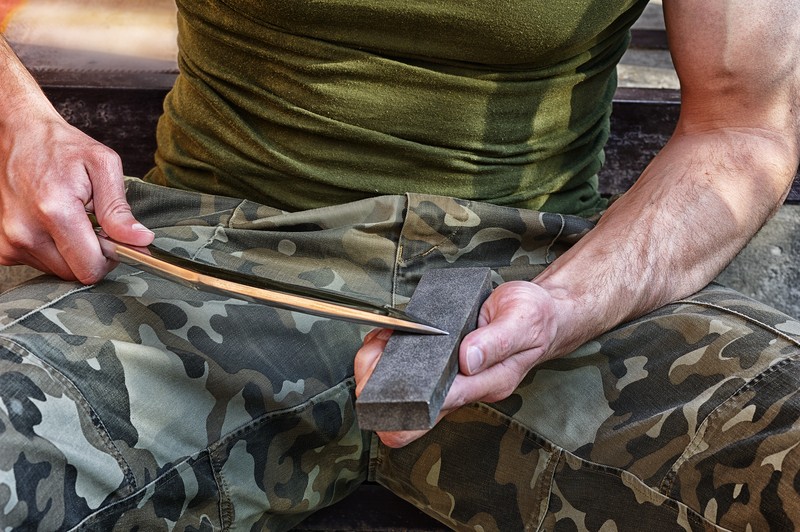You could have the most expensive and finest knife possible, but if you don't know how to maintain its blade properly, you may as well have a $5 flea market blade. Knowing what tools to use and what angles to maintain are the secrets to effective knife blades. Learn these secrets below.
The secret to sharpening a knife to its sharpest possible edge is to maintain consistency of angle while drawing the blade across an abrasive surface.
It’s all about the proper angle (degrees) and keeping it the same while sharpening (and of course, the materials of the abrasive sharpening surface).
An important prep item for the preparedness-minded is a knife sharpener. Considering that most everyone has at least a pocket knife (and likely additional knives), the question is, how many people have a proper knife sharpener to maintain a very good cutting edge?
Do you know the proper angle to sharpen your knife? Did you know that dependent upon manufacturer and model that knives having different bevel angles?
Every time that you sharpen a knife, you are removing metal from the blade. The key to restoring a sharp cutting edge is to use an adjustable knife sharpener (unless you are very skilled) which is set to the same angle as your knife edge. An alternative is having a fixed angle knife sharpener that is the same (degrees) as your knife’s bevel angle.
With that said, here are some general guidelines.
Common Sharpening Angles (degrees per side):
Pocket Knives – 20
Hunting Knives – 22
Euro/American Kitchen Knives – 20
Asian Edge Kitchen Knives – 16
Fillet Knives – 16
Tactical Knives – 23
Sharpening Abrasives
Types of sharpening abrasive materials include Diamond, Carbides, Ceramics, Arkansas Stones, and Synthetics. Each have their own unique characteristics and sharpening capabilities.
Ceramics: removes very little metal; excellent for finishing and maintaining a sharp edge. Can come in different grits, colors, or shapes.
Arkansas Stones: They remove the least amount of metal while polishing your edge to razor sharpness; No other sharpener can perform both these tasks simultaneously.
Synthetic: man-made stone; great for quick edge setting as well as final finishing. They also come in multiple grits, colors, or shapes.
Of course, there is much more to this topic than the ideas presented here, but for excellent overall application, the tips above will serve you very well. If you want to be sure of the ideal blade angle for your knife, you should look at the manufacturer specs, which will list the ideal edges to be placed on the knife.
All of this is good advice, but for a truly exceptional blade edge, it's recommended that you utilize a diamond stone for establishing your edge and an Arkansas stone for polishing the blade to a glass-smooth finish that is guaranteed not to slip when cutting.
This is all excellent advice for preppers and knife enthusiasts everywhere. You can learn more by reading the original article at Modern Survival Blog.

Britney Lockhart
Lol
Weiller Tsujioka aprende aí kkk
Then the blade will chip.. I’d rather have a semi-dull blade
Trace
That’s a kukri , not a knife 🙂
Larry Axelson
…and the steel it’s made of. Different steels and angles for different jobs.
So what the article tells you is that the angle is the most important thing when sharpening a knife then proceeds to explain it is a very difficult thing to do by eye, which it is. So then it tries to sell you a 300-600 dollar sharpener. No doubt it’s a good sharpener, but I will stick to eyeball’in it.
Kukri is a blade style. That would be like saying a mustang isn’t a car just because it has a specific name.
I have a glock model 81
Anyone have experience sharpening that knife or sharpening spring steel?
And water is wet and the sky is up.
Kit Callahan
Nancy Cardoza
Sharpening a knife isn’t that difficult. Do you want a surgical scalpel?
Bryan Lane
You can also use a car windo
Why is this all caps? Shouldn’t secret technique be all caps to emphasize that it’s a secret technique…it seem like you want me to buy something… No soliciting thanks
Nick Ballou
Its called take your time an do it right
Calvin just passed his Trail Life test for knife safety and proper sharpening techniques.
You never sharpen towards yourself!
Joe Howell mine needs sharpened!!!
If you see a knife on my person you can bet it has a surgical edge. I do everything by feel more than eye. I use a file to shape and repair the blade then i start with a dry stone move to a wet med grit then diamond grit then i use a leather belt.
Yes Mam.
John Centre
Maria Guerrero
Love the kukri blade design.
My dad would put an edge on a knife, so sharp it would cut your pant leg whipin’ it backwards.
Sharper the blade, the faster the edge dulls and the more brittle it is
Secret…..not really…mostly forgotten definitely “modern” society has created a population incapable of fending for themselves
John Povlsen
Razor sharp is for razors. Axe sharp is for axes.
Different edges for different uses.